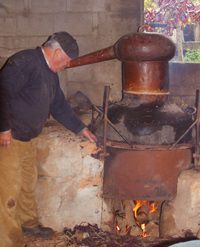Simple Distillation
How does it work? By way of example when boiling water we have often observed how the steam from a kettle condenses back to water when it comes in contact with a cold surface. This simple technique is applied to the separation of a mixture into its different parts by boiling the mix in a boiler, condensing the vapours and collecting the resultant liquid.
The process begins by heating a fermented mash or wash, in the boiler of a pot still or alembic. As the temperature rises the most volatile constituents of the mixture (those that vaporise at lower temperatures) begin to evaporate first. This will permit us to isolate the different components of the mixture as these will dominate at different temperatures. By taking accurate temperature readings one can ascertain which component is dominating at that temperature.
As the vapours accumulate in the head of the alembic they find their way to the condensing recipient via a connecting tube or swan neck.

In the case of the traditional alembic the swan neck tubing leads to a serpentine coil in the condenser filled with running cold water. Once the vapours come into contact with the cold surface of the serpentine coil they condense to their liquid state and trickle down to where they are collected, in an appropriate vessel drop by drop. This process has to be carefully monitored so you know exactly what you are collecting at any given stage of the distillation as we do not want to be collecting any harmful substances. (see Basic distillation rules ).
Most distillation methods are based on the simple distillation method with some modifications. Simple distillation is quite adequate for isolating fractions from a wide variety of substances with different boiling points and may be used for distilling seawater into pure water, for example. Hydrolats or floral waters are also distilled in this way. Obviously its main application is for the distillation of alcoholic spirits from any number of fermented substances in which alcohol is present. It may seem obvious to say that, but to clear up any apparent misconception it must be stated once again that what we are doing here is not making something new which was not there to begin with but simply separating the alcohol from the mix.
So you will end up with the same amount alcohol but more highly concentrated.
Alembic stills yield better taste and more characteristic distillates but are slow and require more labour. Nonetheless single malt Scotch whiskey producers, a few rum manufacturers and other quality oriented distillers employ pot stills. In the U.S.A. more and more small distilleries are using alembic stills to produce high end products that are appreciated for their subtle refined taste.

